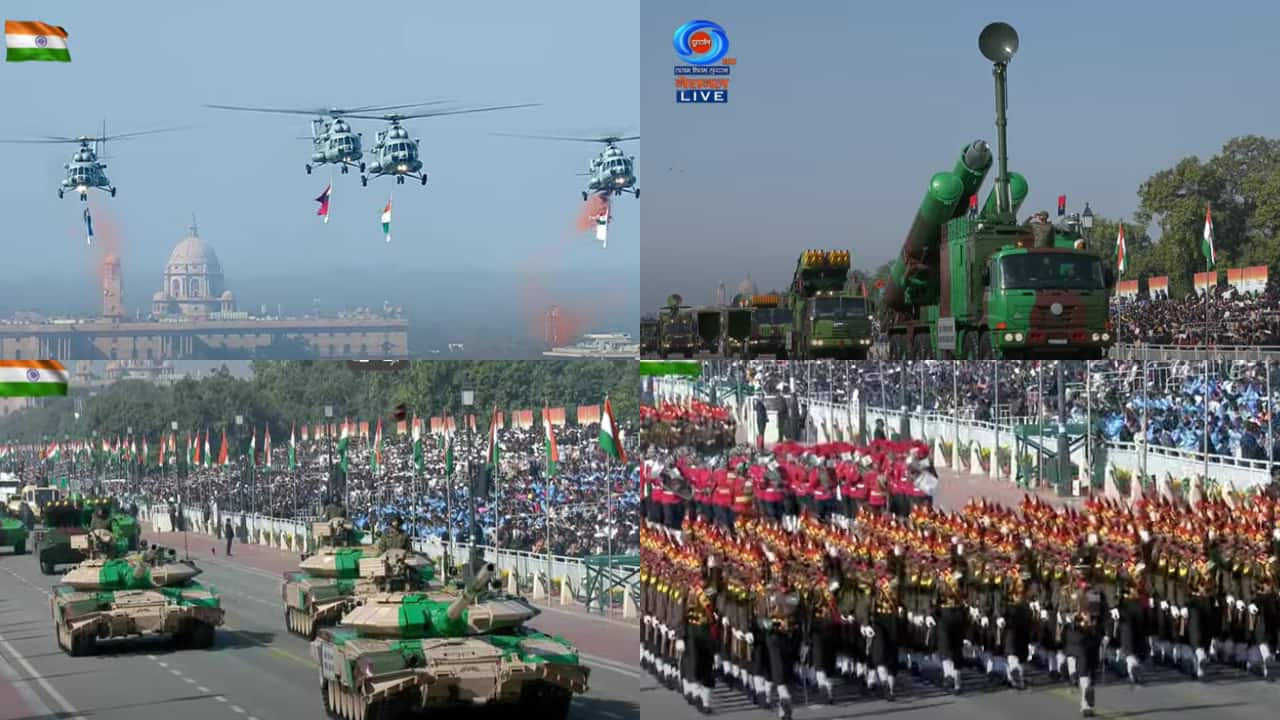 |
|
India's 76th Republic Day celebration on January 26th, 2025, was a spectacular display of the nation's military prowess, showcasing its advanced indigenous weaponry and the strength of its tri-services. The event was graced by Indonesian President Prabowo Subianto as the chief guest, marking a significant diplomatic moment. The parade, held along Kartavya Path, the renamed Rajpath, was a meticulously choreographed spectacle that highlighted India's commitment to national security and its growing self-reliance in defense manufacturing. The central theme, 'Shashakt aur Surakshit Bharat' (Strong and Secure India), resonated throughout the display.
The parade commenced with President Droupadi Murmu taking the salute, followed by a procession of diverse military units. A key highlight was the inaugural appearance of a tri-services tableau, illustrating the increasing synergy and joint operational capabilities among the Army, Navy, and Air Force. This tableau depicted a simulated battlefield scenario, showcasing the integrated capabilities of the indigenous Arjun battle tank, Tejas fighter aircraft, and advanced light helicopters, underscoring the successful integration of land, air, and naval assets in a unified defense strategy. This symbolic representation served as a powerful testament to India's evolving military doctrine.
The mechanized columns presented a formidable array of modern weaponry, including the T-90 Bhishma tanks, NAG missile systems, BrahMos supersonic cruise missiles, Pinaka and Agnibaan multi-launcher rocket systems, Akash weapon systems, and the integrated battlefield surveillance system. The display also showcased sophisticated support vehicles like the Light Specialist Vehicle Bajrang, Airawat infantry mortar system, Nandighosh and Tripurantak quick reaction force vehicles, and the short-span bridging system, all underscoring the diverse capabilities of the Indian armed forces. This display not only highlighted the country's technological advancements but also provided a glimpse into the future of Indian warfare, focusing on integrated operations and sophisticated technology.
The marching contingents from various Army regiments, including the Brigade of the Guards, Jat Regiment, Garhwal Rifles, Mahar Regiment, Jammu and Kashmir Rifles Regiment, and the Corps of Signals, commanded attention with their precision and discipline. The Indian Navy's contingent, led by Lieutenant Commander Sahil Ahluwalia, presented a tableau depicting a self-reliant ('Aatmanirbhar') Navy, showcasing indigenous warships like the INS Surat destroyer, INS Nilgiri frigate, and INS Vaghsheer submarine. This emphasized India's substantial progress in indigenous warship design and construction, signaling a clear shift towards greater self-sufficiency in naval capabilities. The Indian Air Force (IAF) contingent, under the leadership of Squadron Leader Mahender Singh Garati, followed with a captivating fly-past of three MiG-29 aircraft in 'Baaz' formation.
Beyond the active military, the parade also paid tribute to veterans with a tableau titled 'Viksit Bharat ki Ore Sadaiv Agrasar' (Always progressing towards a developed India). This segment served as a powerful acknowledgment of the contributions of ex-servicemen and women, celebrating their unwavering dedication and commitment to the nation. The participation of veteran sportspersons added another layer of national pride to the event. The Defence Research and Development Organisation (DRDO) showcased its achievements in indigenous technology with a tableau themed 'Raksha Kavach – Multi-layer Protection against Multi-domain Threats.' This included cutting-edge systems like the quick reaction surface-to-air missile, airborne early warning and control system, and drone detection and destruction systems. The first-time public display of the indigenously-developed Pralay missile system was a particular highlight, showcasing India's advancements in missile technology.
The participation of a 352-member marching and band contingent from Indonesia added an international dimension to the parade, marking the first time an Indonesian contingent participated in a foreign national day parade. Other notable contingents included an all-women marching contingent from the Central Reserve Police Force (CRPF), led by Assistant Commandant Aishwarya Joy M; the Assam Rifles contingent; the Border Security Force (BSF) Camel contingent; and marching contingents from the National Cadet Corps (NCC) – both all-girls and all-boys contingents – and the National Service Scheme (NSS). The diverse representation of India's security forces and civilian organizations served to reinforce the national unity and spirit of the Republic Day celebration. The entire spectacle served as a potent display of India's military strength, technological advancements, and its commitment to a secure and prosperous future.
In conclusion, the Republic Day parade 2025 was more than just a military display; it was a powerful statement of India's growing global influence and its determination to secure its national interests. The parade underscored India's commitment to technological self-reliance, its strengthened military cooperation with global partners, and its dedication to honoring the contributions of its armed forces and citizens. The event’s success reinforces India’s position as a significant player on the world stage, capable of safeguarding its own security and contributing to global peace and stability.
Source: Republic Day 2025: India's military prowess on full display at R-Day parade
